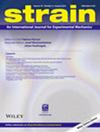Identifying hyperelastic constitutive parameters with sensitivity‐based virtual fields
IF 2.4
3区 材料科学
Q2 MATERIALS SCIENCE, CHARACTERIZATION & TESTING
引用次数: 8
Abstract
This work deals with the identification of hyperelastic constitutive parameters using the virtual fields method. The choice of the virtual displacement fields is a crucial aspect of the method, typically for reducing the sensitivity to the measurement noise. A first and simple option is to generate the virtual displacement fields randomly. Nevertheless, in case of hyperelastic models for which the stress is not a linear function of the constitutive parameters, improving the choice of the virtual displacement fields is not trivial and an alternative strategy has to be found. In the present study, the sensitivity‐based virtual fields approach is applied and compared with the randomly generated virtual displacement fields approach. Two material models were considered: the Mooney model, which describes quite well the behavior of hyperelastic materials for small and moderate strains, and the Ogden model, which accounts for the stress hardening phenomenon observed at higher strains. The full kinematic fields are measured by using the digital image correlation technique during an equibiaxial tensile test performed on a cruciform specimen. Identification results are discussed through their capability to predict the external force measured during the test. The sensitivity‐based virtual fields approach is found to improve significantly the prediction compared with the randomly generated virtual displacement fields approach.基于灵敏度的虚拟场识别超弹性本构参数
本文研究了用虚场法识别超弹性结构的本构参数。虚拟位移场的选择是该方法的一个关键方面,通常是为了降低对测量噪声的灵敏度。第一个简单的选择是随机生成虚拟位移场。然而,对于应力不是本构参数线性函数的超弹性模型,改进虚拟位移场的选择并非易事,必须找到一种替代策略。本文采用了基于灵敏度的虚拟场方法,并与随机生成的虚拟位移场方法进行了比较。考虑了两种材料模型:Mooney模型,它很好地描述了小应变和中等应变下超弹性材料的行为,以及Ogden模型,它解释了在高应变下观察到的应力硬化现象。利用数字图像相关技术在十字形试样上进行等双轴拉伸试验时测量了完整的运动场。通过其预测试验中测量的外力的能力,讨论了识别结果。与随机生成的虚拟位移场方法相比,基于灵敏度的虚拟场方法显著提高了预测效果。
本文章由计算机程序翻译,如有差异,请以英文原文为准。
求助全文
约1分钟内获得全文
求助全文
来源期刊

Strain
工程技术-材料科学:表征与测试
CiteScore
4.10
自引率
4.80%
发文量
27
期刊介绍:
Strain is an international journal that contains contributions from leading-edge research on the measurement of the mechanical behaviour of structures and systems. Strain only accepts contributions with sufficient novelty in the design, implementation, and/or validation of experimental methodologies to characterize materials, structures, and systems; i.e. contributions that are limited to the application of established methodologies are outside of the scope of the journal. The journal includes papers from all engineering disciplines that deal with material behaviour and degradation under load, structural design and measurement techniques. Although the thrust of the journal is experimental, numerical simulations and validation are included in the coverage.
Strain welcomes papers that deal with novel work in the following areas:
experimental techniques
non-destructive evaluation techniques
numerical analysis, simulation and validation
residual stress measurement techniques
design of composite structures and components
impact behaviour of materials and structures
signal and image processing
transducer and sensor design
structural health monitoring
biomechanics
extreme environment
micro- and nano-scale testing method.
 求助内容:
求助内容: 应助结果提醒方式:
应助结果提醒方式:


